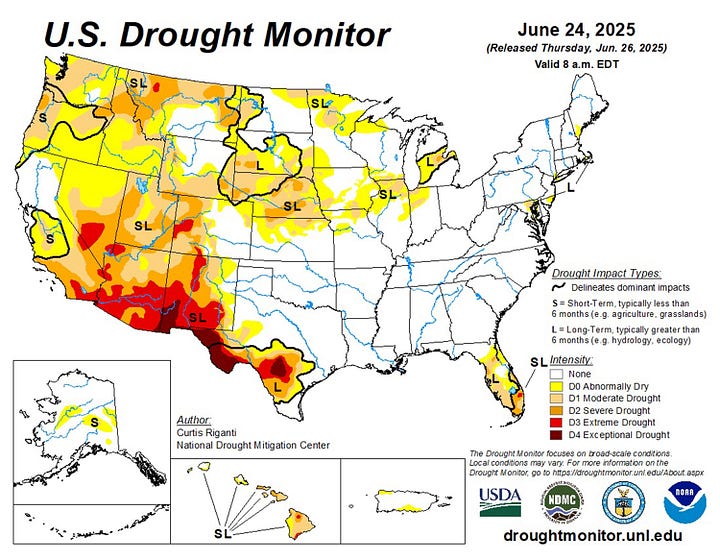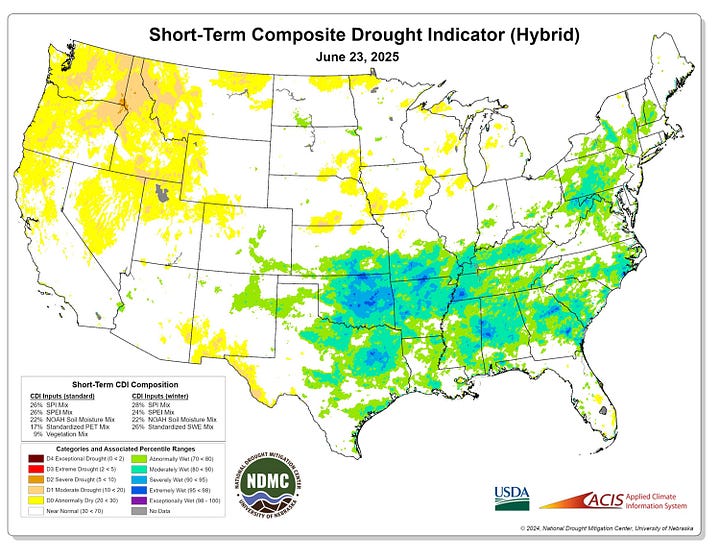I woke up in the night to another round of thunderstorms. I used to live on the equator, where thunderstorms were a daily event, but in the Bluegrass this year, rain and thunderstorms are almost daily events as well.
Look at these maps. The one on the left is probably familiar to you. It shows drought in the continental US and is a bit alarming, with very dry conditions in the west. But this map is misleading, making it seem as if the east is “normal” (whatever that is). Now look at the much more informative map on the right. It combines drought and soil moisture. The entire eastern US is exceptionally wet and has been all spring and summer.


The map on the right is much more useful. By adding soil moisture, we get a better sense of the growing conditions for plants in agriculture and forestry. When we are using maps to illustrate fainfall and drought, we should use the Short-Term Composite Drought Indicator.
These maps show current conditions, but a longer-term view of climate events shows that the eastern half of our continent experiencing a series of events that are increasing forest growth: rainfall is greater; more precipitation comes as rain rather then snow; growing seasons from leaf-out to leaf-drop are longer; nitrogen deposition in rainfall has increased; and carbon dioxide concentrations are higher. Carbon dioxide emissions due to fossil fuel combustion are the major cause of climate change. This is true, but its increase is also stimulating photosynthesis (more on this in a future story).
While increased rainfall and increased forest growth in the eastern US may be a good thing, this should not be taken as an excuse to slow our efforts to end climate change due to fossil fuel use: worldwide, climate change is a disaster that must be ended. Fortunately, we have the tools to do this: a rapid conversion from fossil fuels to renewable energy and energy conservation is essential to the future of our society.



My wife and I planted a bare root bur oak in spring 2023. (We live in southeast PA). Don’t know how old it was then, but couldn’t be too old. It was about 12 feet tall. It’s nearly double in height now, and I’m even spotting acorns! After reading this, I’m wondering, how much can the rain of the past few years, along with steady watering I did during the one drought we had, explain this anomaly in early maturation?
thanks. I had never seen the soil moisture maps before, just never knew to look for them, so thanks for the link. The excess moisture is very obvious this year in terms of vegetation growth, we are seeing new plants that we've never really noticed before. The cliff behind our house which is shaded most of the day, getting sunlight only in the mid to late afternoon and then generally only in the summer months, have always had a lot of jewel weed on them (and shade and moisture loving plant), but this year another herbaceous plant with much larger leaves and fewer smaller flowers has taken over and crowding out a lot of the jewel weed. It's probably been there before, just not in this abundance. I worry about the jewel weed being over taken, because it is an important food source for migrating hummingbirds who show up just about the time the jewel weed blooms in late August and September.